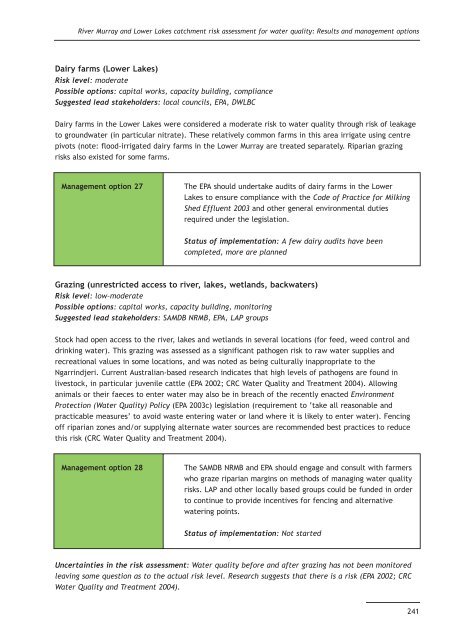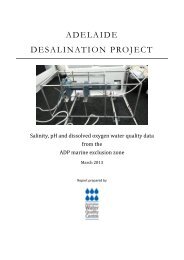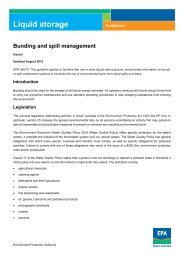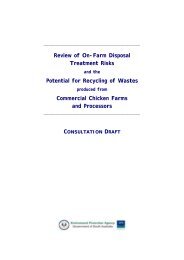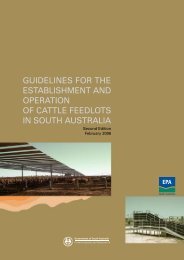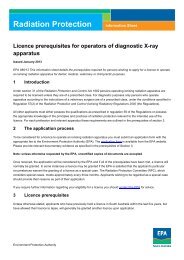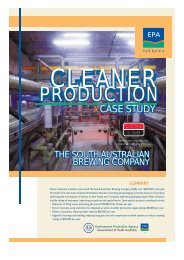2 Renmark to border LAP area assessment - EPA - Sa.gov.au
2 Renmark to border LAP area assessment - EPA - Sa.gov.au
2 Renmark to border LAP area assessment - EPA - Sa.gov.au
You also want an ePaper? Increase the reach of your titles
YUMPU automatically turns print PDFs into web optimized ePapers that Google loves.
River Murray and Lower Lakes catchment risk <strong>assessment</strong> for water quality: Results and management options<br />
Dairy farms (Lower Lakes)<br />
Risk level: moderate<br />
Possible options: capital works, capacity building, compliance<br />
Suggested lead stakeholders: local councils, <strong>EPA</strong>, DWLBC<br />
Dairy farms in the Lower Lakes were considered a moderate risk <strong>to</strong> water quality through risk of leakage<br />
<strong>to</strong> groundwater (in particular nitrate). These relatively common farms in this <strong>area</strong> irrigate using centre<br />
pivots (note: flood-irrigated dairy farms in the Lower Murray are treated separately. Riparian grazing<br />
risks also existed for some farms.<br />
Management option 27 The <strong>EPA</strong> should undertake <strong>au</strong>dits of dairy farms in the Lower<br />
Lakes <strong>to</strong> ensure compliance with the Code of Practice for Milking<br />
Shed Effluent 2003 and other general environmental duties<br />
required under the legislation.<br />
Status of implementation: A few dairy <strong>au</strong>dits have been<br />
completed, more are planned<br />
Grazing (unrestricted access <strong>to</strong> river, lakes, wetlands, backwaters)<br />
Risk level: low–moderate<br />
Possible options: capital works, capacity building, moni<strong>to</strong>ring<br />
Suggested lead stakeholders: SAMDB NRMB, <strong>EPA</strong>, <strong>LAP</strong> groups<br />
S<strong>to</strong>ck had open access <strong>to</strong> the river, lakes and wetlands in several locations (for feed, weed control and<br />
drinking water). This grazing was assessed as a significant pathogen risk <strong>to</strong> raw water supplies and<br />
recreational values in some locations, and was noted as being culturally inappropriate <strong>to</strong> the<br />
Ngarrindjeri. Current Australian-based research indicates that high levels of pathogens are found in<br />
lives<strong>to</strong>ck, in particular juvenile cattle (<strong>EPA</strong> 2002; CRC Water Quality and Treatment 2004). Allowing<br />
animals or their faeces <strong>to</strong> enter water may also be in breach of the recently enacted Environment<br />
Protection (Water Quality) Policy (<strong>EPA</strong> 2003c) legislation (requirement <strong>to</strong> ‘take all reasonable and<br />
practicable measures’ <strong>to</strong> avoid waste entering water or land where it is likely <strong>to</strong> enter water). Fencing<br />
off riparian zones and/or supplying alternate water sources are recommended best practices <strong>to</strong> reduce<br />
this risk (CRC Water Quality and Treatment 2004).<br />
Management option 28 The SAMDB NRMB and <strong>EPA</strong> should engage and consult with farmers<br />
who graze riparian margins on methods of managing water quality<br />
risks. <strong>LAP</strong> and other locally based groups could be funded in order<br />
<strong>to</strong> continue <strong>to</strong> provide incentives for fencing and alternative<br />
watering points.<br />
Status of implementation: Not started<br />
Uncertainties in the risk <strong>assessment</strong>: Water quality before and after grazing has not been moni<strong>to</strong>red<br />
leaving some question as <strong>to</strong> the actual risk level. Research suggests that there is a risk (<strong>EPA</strong> 2002; CRC<br />
Water Quality and Treatment 2004).<br />
241


